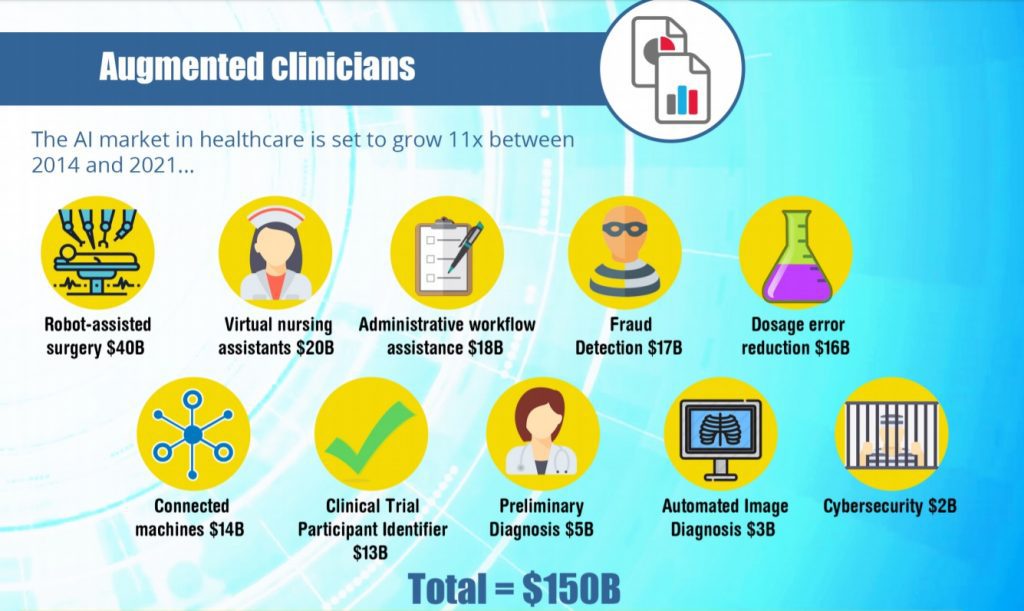Introduction
Today, every business owner requires insights to stay relevant in the market. If you need to determine your target audience, find out what your clients want and predict their needs. Incidentally, big data is a major part of your decision-making. The correct data processing and analysis will lead to you achieving these goals.
We are exposed to an astonishing amount of information. According to Northeastern University, the total amount of data globally constituted 4.4 zettabytes in 2013. In 2020, however, it is expected to rise to an enormous 44 zettabytes. Take a look at this:

This information can bring value to enterprises and the way they can leverage AI algorithms to process it. As a result, companies are able to understand and influence clients’ behavior. In 2018, over 50% of companies on the planet had already adopted Big Data. So, what exactly is it?
Don't have time to read?
Book a free meeting with our experts to discover how we can help you.
Book a MeetingWhat Is Big Data?
Gartner defines Big Data as “high-volume and/or high-variety information assets that demand cost-effective, innovative forms of information processing that enable enhanced insight, decision-making, and process automation.”
Simply put, Big Data is a term that includes every tool and process that helps people utilize and manage huge sets of data. The concept was created out of the necessity to capture trends, preferences, and user behavior into a single place (the so-called data lake) for when people interact with various systems and each other. Big Data can help companies analyze and figure out the motivations of their most important clients, while also providing ideas for the creation of new offerings.
Why Is Big Data So Important?
As we’ve mentioned above, data is a crucial part of understanding the target demographics and motivation of customers. When the customer interacts with the technology in an active or passive way, data that describes their actions can be created. Cameras, credit cards, smartphones, and purchased products all contribute to the data profile. If done right, the analysis can tell a lot about personality, behavior, and the events occurring in a customer’s life. Companies can use these insights to improve a product, adjust their business strategy, and boost marketing campaigns — and ultimately get closer to their client.
For years, experts have discussed Big Data and its business impacts. However, only recently has the technology evolved to the point where it is actually achievable. Now, large datasets can be analyzed quickly and efficiently. Forty-four zettabytes in 2020? Well, the amount of structured and unstructured data will increase in the coming years. Only by collecting and processing it can companies get the AI insights that will help them generate excellent profits and prepare for the future.
Even the smallest companies will adjust their operations to experience the benefits of Big Data. It will happen because data collection and interpretation is becoming more accessible than ever. Every day we find out about innovative technologies that are cost-efficient and very easy to implement.
The Benefits of Big Data combined with the Artificial Intelligence
Breakthroughs in AI solutions development are opening possibilities for entirely new use cases with additional types of data. The AI can easily handle processing pictures, voice, and videos like never before. Big Data needs Artificial Intelligence to unlock its business value to the fullest. The more data AI receives, the smarter it gets. We don’t need to concern ourselves that much about storage space — the bigger, the better!
3 Ways in which Big Data can benefit from AI
You’ve probably heard that AI and its most popular subdivision Machine Learning offer some kind of insights for business owners. Let’s find out exactly what AI/ML could bring to Big Data.
The new methods for data analytics
Probably, the biggest question that comes from implementing Big Data is how to actually handle this variety of information. For a long time, “SQL like” query languages were used by analytics to extract needed data. Then, a lot of effort was spent to derive some useful insights by employing old-fashioned approaches to deal with the data. But now, AI and ML are the methods to take care of this process.
Speeding up data analytics
People are still very important in managing data and its analysis, but Artificial Intelligence could make things run more quickly and efficiently. Letting AI technologies assist humans in the process of data analysis could ultimately result in faster decision-making for the company and more insights.
Eliminating data problems
Every time people talk about Big Data, the question about the quality of data pops up. A low quality of information means little to no value. ML algorithms can definitely help with this, because the secret of the ML projects is that 80% of the overall time is spent on cleaning or preparing information. ML algorithms are able to detect missing or outlier values, normalize data to common terminology, and distinguish the different records that describe the same thing with slightly different technology.
What Does Big Data Means for Businesses?
Implementing Big Data with Artificial Intelligence has already been vital for many top businesses to beat their competition. It doesn’t really matter whether it is a new company or an established leader on the market – they all use data-driven strategies to turn information into tangible value. It is possible to find a Big Data use case in almost every industry, from IT and Banking to Agriculture and Healthcare.
Business experts are acknowledging that Big Data and Artificial Intelligence can create new ideas for growth and expansion. There is even a possibility that a new type of business will be getting popular soon – data analyzing and aggregation companies for particular industries. The sole purpose of those organizations will be processing the enormous flows of data and generating insights. Before this actually happens, businesses should empower their Big Data capabilities very intensively. In the past, estimations were made based on the retrospective point of view. Leveraging real-time analysis, Big Data can empower the predictions and allow strategists to test assumptions and theories faster.
What are the Implications of Big Data?
The level of understanding of the current infrastructure and client engagement will determine the opportunities for businesses to unlock hidden insights and gain an advantage over competitors. Big Data and Artificial Intelligence can offer multiple opportunities for growth. Now, let’s talk about the three most important ones.
Quicker and more precise decision-making
If you combine AI insights, the speed of data analytics technology, and access to new sources of information, you will get a once unimaginable level of informed decision-making based on smart and accurate analyses.
Improved automation
One of the benefits of Big Data is the ability to automate processes, which boosts efficiency. The price of Cloud computing is decreasing, making massive data storage more affordable. By adding scalable IT infrastructure, automated data collection will be easier than ever.
Deeper Insights
Big Data introduces entirely new levels of uncovering hidden opportunities. Organizations couldn’t analyze such large sets of data in the past, but now the ability to do that could result in unexpected business value. Giant datasets could be easily used to innovate the product development process. Getting a hold of patents in already existing and developed markets could be a crucial factor for determining the position of a company in an industry.
Artificial Intelligence and Big Data Applications
Let’s take a closer look and find out what value Big Data powered by Artificial Intelligence can bring to existing business in various industries.
AI in Retail
The first usage is making sense of data silos in the organization. As a retail company evolves and grows, it becomes much harder to make sense of all the information coming to the different departments. Data is not located in one place like a warehouse. Every Like, Tweet, or comment is an element in the bigger picture of customer behavior. The goal for AI and Big Data in retail is to collect all this information in one place and make sense of it. By introducing multiple data points and using advanced Machine Learning techniques, it is possible to create a model for a customer’s journey and predict customer behavior.
The second application is the creation of an immersive shopping experience for the customer with seamless transitions from offline to online shopping. Augmented Reality, Artificial Intelligence, and Big Data provide customers with the opportunity to try products at every touchpoint. The Smart Fitting Room concept is a perfect example of this. When customers try on models of clothing, the system can provide recommendations based on styles and preferences. The platforms from Alibaba are using “Fashion AI” technology that leverages over 500,000 pieces of data on fashion and advice from stylists to offer personalized recommendations. Alibaba also uses a digital screen that is called “magic mirror.” This solution allows customers to try on different clothing virtually, and then buy it via Alibaba’s payment service by scanning the QR code on the screen.
Finally, AI and Big Data can help create a supply chain that is data-driven and transparent. Machine Learning can find the most important factors fast and drive the success of the chain.
When all links in the supply chain become smart, business owners will receive benefits like:
- Forecasting inventory levels in real time
- Being able to check the quality of supplies
- Predicting demand
- Planning production
- Optimizing delivery and transportation
Hema Xiansheng from Alibaba is a great example of a supermarket working with this technology. Every product in the supermarket is digitized. Customers can scan barcodes and get complete information on the product. Then, considering the customer’s previous buying history, a real-time recommendation is offered. All of this is achieved by an effective combination of a large database and an AI-driven analysis and suggestions system.
AI in Healthcare
Artificial Intelligence, Big Data and Machine Learning in healthcare have already been implemented in numerous ways in hospitals around the globe. In the context of radiological diagnostics, cognitive computing systems are used to facilitate repetitive processes and create sample analyses. Learning and predictive functionality is added, which moves it to the Machine Learning territory.
Or we could mention the Deep Learning Model from Stanford University or Google Brain. Technology here is used to predict the approximate time of death for patients with life-threatening conditions and building strategies for the best treatment.
Robotic systems like surgical robots are another way to use AI technology. They could be the only possible solution for high-precision surgeries in the future, which expands people’s possibilities for treatment. Robots could also make a difference in the rehabilitation period after an operation by offering logistics support for hospitals. With the evolution of AI technology and the availability of information, the contexts for the usage of medical robots will only increase.

AI in the Food Industry
One of the best ways to implement Artificial Intelligence and Big Data in the food industry is for data prediction. It is a relatively new market, and there are already startups tapping into it.
Ida from Connecterra is using AI to help farm owners predict and prevent some health problems with the cattle they own. While protecting the actual assets, the data gathered from the farm helps keep cattle healthy and capable of producing higher-quality beef and milk. The Yield startup is monitoring agriculture and aquaculture environments to create predictions and offer insights.
The American startup Brightseed is doing something really unique and intriguing. AI and Big Data-powered predictive analytics are used to discover beneficial plant compounds. The deal is that less than 0.1% of possible plant compounds have been discovered. These compounds will be used to create bioactive compounds that will make food more nutritious and healthy. This will ultimately revolutionize the food industry as we know it.
These are just a few of the current use cases in the food industry, but many more are expected in the future:
- AI will improve restaurant-management software to the extent that it will allow managers to be informed on product availability and correct pricing, adjusting to trends and customer preferences beforehand.
- Knowing your tastes, time of the day, and your travel plans, a restaurant could suggest that you should visit soon and offer you some food to order that you might like.
- Mobile Applications will analyze the supply chains of restaurants and provide recommendations on the ones with the freshest ingredients.
- Considering trends, food manufacturers will produce food and beverages that will satisfy the current tastes of customers in the shortest amount of time.
AI Insights in Business Analytics
Analytics helps build a strategy for businesses based on available information. It takes time and effort to create structured dashboards and reports, but even more time to effectively use the data. Based on data analysis, you can be alerted to problems, find new solutions, and receive ideas for new opportunities. But with the massive stream of information available, sometimes it can be really hard to determine what is important, what’s not, and how to deal with it. Machine Learning can help in the analytics process, recognize unusual patterns in processes instantly, and give you suggestions on what to do next; this process will provide valuable AI insights.
According to Capgemini Digital Transformation Institute, there have already been some tangible benefits for businesses that have implemented AI:
- 75% of organizations have increased their sales of new products and service offerings by more than 10%.
- For 78% of those organizations, operational efficiency has also increased by over 10%.
- 79% of organizations have generated new insights and significantly improved their analyses.
- 75% of organizations have improved customer satisfaction by more than 10%.
There are basically four Artificial Intelligence and Machine Learning strategies for Big Data analytics.
Descriptive analytics in simple terms describes what has happened. It summarizes everything and provides reports on situations. Data categorized in a historical context will help make educated guesses about what will come next.
Diagnostic analytics breaks down all received information in an effort to answer the question “Why and how did certain events happen?” The investigation is performed by comparing various sets of data.
Predictive analytics is for recognizing patterns and matching events to those patterns to predict the events that will occur in the future. A Narrative Science study claims that around 25% of enterprises have already implemented predictive analytics.
Prescriptive analytics suggests the best ways to take action in a particular situation.
Conclusion
In 2022, one in five workers doing generally non-routine tasks will be replaced by Artificial Intelligence, according to Gartner’s predictions. Will it happen? Only time will tell. But we can say with certainty that competitors will replace businesses that ignore AI/ML technology that can handle Big Data. SPD Technology provides AI development that helps businesses grow and also offers Fraud Detection and Prevention functionality, which elevates business security to an entirely different level. If you are interested in Artificial Intelligence and Machine Learning development, contact us!
Ready to speed up your Software Development?
Explore the solutions we offer to see how we can assist you!
Schedule a Call
